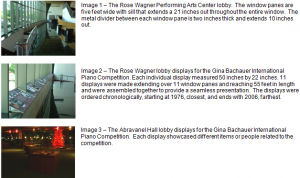Samuel Yamamoto and Professor David Day, Music and Dance Library
The Gina Bachauer International Piano Competition is the second largest piano competition in the United States. Established in 1976 at Brigham Young University by Dr. Paul Pollei, the Gina Bachauer International Piano Competition was given its name in 1977 to honor the world-renowned Greek pianist, who had strong ties to the Utah Symphony and symphony director, Maurice Abravanel. Since its inception, the Gina Bachauer International Piano Competition has grown tremendously in size and has since moved the headquarters to the Rose Wagner Performing Arts Center in Salt Lake City, Utah.
40 competitors from 24 countries competed in the 2006 competition. All competitors performed in three rounds at the Rose Wagner Performing Arts Center. Judges selected 6 finalists for the final round of competition, which concluded at Abravanel Hall in Salt Lake City, Utah, with the Utah Symphony
The Gina Bachauer Cempetition Display and Archive Project entailed two related objectives. The primary objective was to create two separate displays to commemorate the 30-year anniversary of the competition. These displays were shown in the lobby of the Rose Wagner Performing Arts Center during the first three rounds of competition and separate displays were created for the final round of competition in Abravanel Hall.
The secondary objective of the project was to organize and archive the Gina Bachauer International Piano Foundation materials. In order to complete primary objective of creating the displays, files and documents needed to be organized into a practical system that would benefit our purposes as well as future persons. These files and documents were donated by Dr. Paul Pollei, founder and artistic director of the Gina Bachauer International Piano Foundation.
Knowing the magnitude of the organizing and archiving, David Day hired Amalie Wickes to assist me in this objective, which took the entire summer to complete. Because of the extent of the archival work, I needed to work on the displays concurrently with the organizing and archiving of materials.
These materials were placed in boxes by relatively close years, but this was the extent of their similarities and organization was limited in each box. There were approximately 60 storage boxes of materials. Materials were organized into archival boxes designed to hold and preserve materials. This organization dramatically reduced the space used by all the materials.
Selected materials for the displays were scanned into the computer, and edited and adjusted in Adobe Photoshop CS2. Images were then imported to a custom made template in Adobe InDesign CS2. Careful measurements were made at the Rose Wagner lobby to ensure the right specifications in InDesign (See Image 1). After composing each display, the displays were ready for printing, which was provided by the Conservation Laboratory in the library. Individual displays were then glued onto foam board. All the displays were inclined 23 degrees, supported by wood frames, which I constructed. The foam board display and wood frames were attached together by velcro at the Rose Wagner Performing Arts Center. The displays were fitted between window panes in the Rose Wagner lobby
Patrons, competitors and staff of the competition were able to view these displays throughout the competition (See Image 2). Dr. Paul Pollei spoke highly of the displays and many other comments were made regarding the professional quality of the work.
The second sets of displays were made for Abravanel Hall. These five displays showcased actual materials from the competition’s history such as two proclamations from U.S. Presidents welcoming the competitors, programs, photos, newspaper articles and two separate displays featuring Gina Bachauer and Dr. Paul Pollei (See Image 3). These displays were relatively easier to create as the materials were already gathered from the first displays.
The project benefited the participants in numerous ways. For example, a library patron greatly increased his research efficiency on his doctoral dissertation on the Gina Bachauer International Piano Foundation. I personally acquired and perpetuated many technical abilities. Further mastery of Adobe Photoshop and Adobe InDesign was augmented. In addition, working with Paul Pollei, David Day, Amalie Whickes, BYU moving, the Conservation Laboratory and Abravanel Hall furthered my administrative skills. The skills I obtained from this project were fundamental for obtaining and executing an $8,600 Laycock Fine Arts Grant that would benefit students of the BYU School of Music. This ORCA project has set a foundation for me in administration, execution, and organization which will greatly assist me in my career pursuits.

